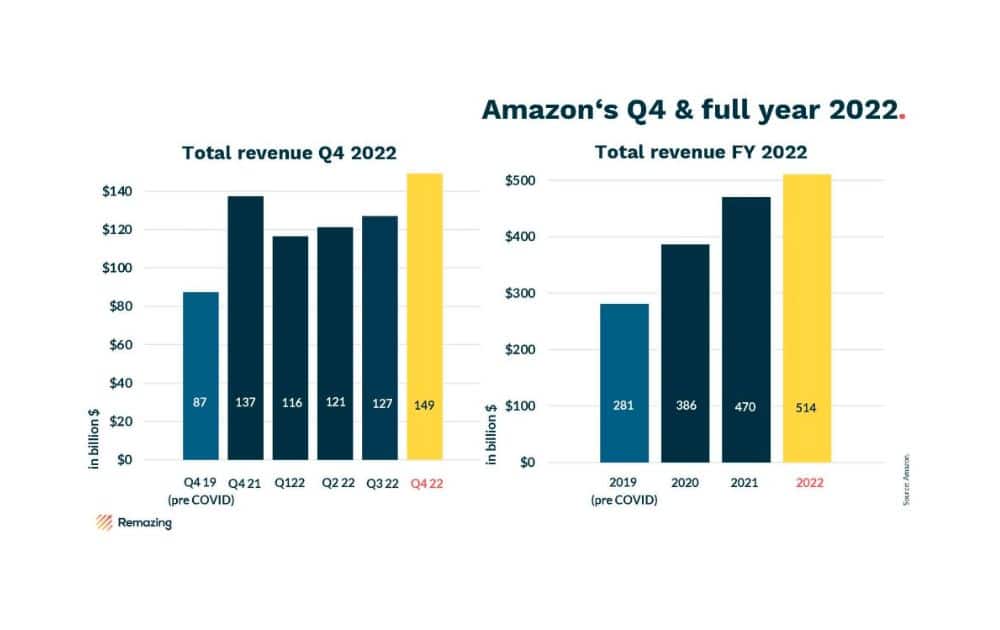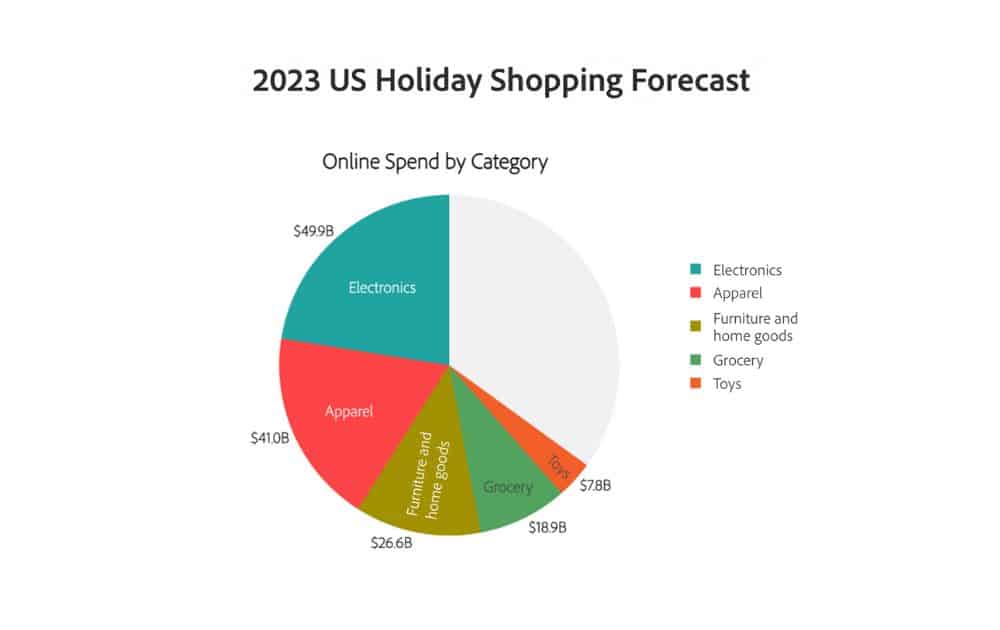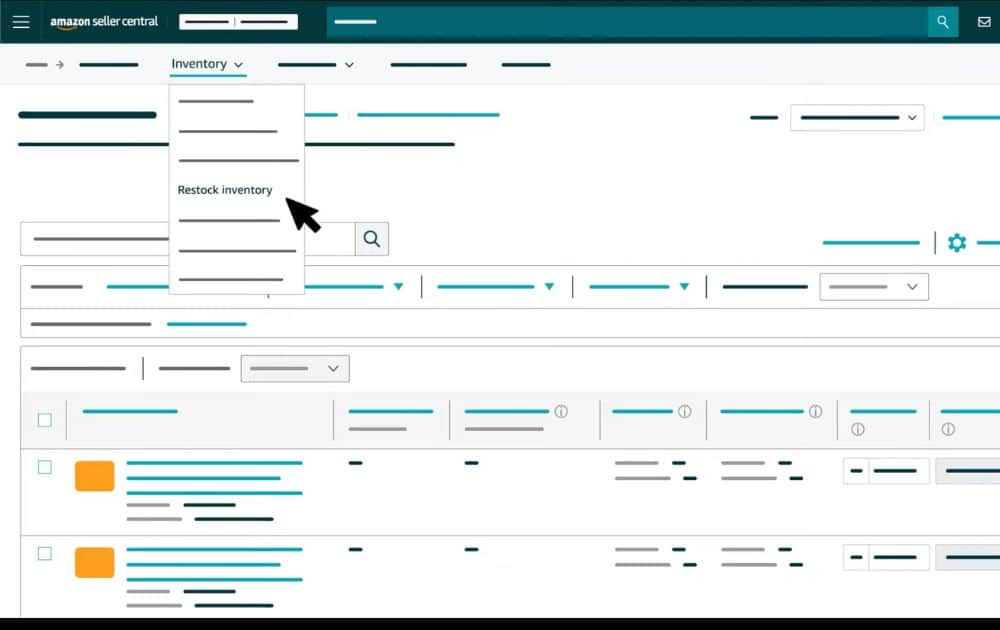Seasonal holidays pop up like confetti at the end of the year, turning ordinary days into sparkly shopping fests. For sellers, these holidays are more than just fun times; they’re golden tickets to boost eCommerce sales.
In this complete guide on how to prepare for Amazon Q4, we’re diving deep into the world of holiday profits and top-notch selling strategies. Ready to unwrap the secrets to making the most of these festive days?
Recognizing Profitable Seasonal Holidays
The end of the year brings colder air, dreamy street lights, and ringing cash registers (or their digital counterparts).
Consumers indeed spend more during seasonal holidays, as proven by Amazon’s data showing a 9% year-over-year increase in net revenue, reaching $149.2 billion in Q4 2022.

Some seasonal holidays are so iconic that even the mere mention of them sends sellers into preparation mode. Here are the big hitters that illustrate the seasonality of Amazon sales and other eCommerce platforms:
Cyber Five
Spanning from Thanksgiving to Cyber Monday in the seasonal holidays 2023 calendar, this five-day spree is a whirlwind of shopping activity. Cyber Five encompasses:
- Thanksgiving Day. While historically a day for spending time with family, many retailers have started to roll out early Black Friday discounts as part of Thanksgiving deals, especially online.
- Black Friday. It is one of the biggest shopping days of the year, known for its significant in-store and online discounts. The truth behind Black Friday is that it’s not just a day but a cultural phenomenon.
- Small Business Saturday. This day encourages consumers to shop at local and independent businesses.
- Sunday. It’s not officially branded, but the deals and shopping momentum generally continue. Some also refer to this day as Cyber Sunday.
- Cyber Monday. One of the most significant eCommerce shopping days, Cyber Monday was initially created to encourage online shopping.
Christmas
Christmas is an important part of the seasonal holidays list both for eCommerce and brick-and-mortar stores. It’s not just the season of goodwill but also the pinnacle of gift-giving, offering sellers vast opportunities to cater to shoppers searching for the perfect presents.
New Year’s Eve
As everyone gears up to ring in the new year, there’s a noticeable uptick in after-Christmas sales, particularly the demand for party essentials, chic outfits, and celebratory items.
While these are the blockbuster events, there’s an array of lesser-known holidays that savvy sellers can exploit. It’s all about tuning into the eCommerce buzz and riding those waves, no matter how big or small.
Here are lesser-known seasonal eCommerce and brick-and-mortar season sales during Q4:
Green Monday
A term coined by eBay in 2007 to describe one of their best sales days, Green Monday happens to be the second Monday of December. Some refer to it as “Cyber Monday’s little brother,” marking another significant online shopping day during the holiday season.
Free Shipping Day
Introduced in 2008 by Luke Knowles, this promotional day is part of seasonal holidays created to appeal to last-minute holiday shoppers who buy gifts online. It falls approximately a week before Christmas and guarantees delivery by December 24th.
Super Saturday
Also called Panic Saturday, this part of the seasonal holidays is the last Saturday before Christmas. Super Saturday is the final opportunity for many in-store shoppers to get their last-minute gifts.
As seen from Adobe’s 2022 Holiday Shopping Trends and Insights Report, sales revenue spiked during Black Friday and Cyber Monday. However, average revenue stayed between $2 billion and $4.5 billion during most days of the quarter.

Though Black Friday and Cyber Monday are the sales highlights of the season, solely focusing on these two seasonal holidays might mean missing out on other lucrative selling opportunities.
Tips to Prepare for Seasonal Holidays 2023
Here are a few tips to prepare for seasonal holidays and Amazon selling events:
Trend Analysis
One of the best ways to prepare for seasonal holidays is to review the data from past years. Identify the products that outperformed others during past holidays. Were there specific items that consistently sold out? On the flip side, which products had lower-than-expected sales?
For instance, Adobe’s 2023 US Holiday Shopping Forecast projects a $49.9 billion spend on electronics, reflecting a 3.4% growth year-on-year. The category’s consistent growth is likely due to substantial discounts.

Interestingly, November is expected to account for 57% of electronics sales, boosted further by Cyber Week. Meanwhile, toy sales will peak in December, capturing 52% of the sales for the month, which is attributed to last-minute shopping.
Aside from electronics and toys, data also forecasts the following product categories to be lucrative:
- Apparel
- Furniture and home goods
- Toys
However, it’s crucial not to ride the wave of forecasts mindlessly and rely on previously successful categories. Instead, delve deeper into the hits. Was it due to effective marketing, timely discounts, or a broader industry trend? Identify the ‘why’ to replicate this success.
Inventory Management
Proper inventory management is pivotal for Amazon sellers to maximize sales and maintain a strong seller reputation during seasonal holidays.
Given potential global supply chain hiccups, it’s crucial to understand the lead time for your products. How long does it take for your supplier to deliver products to you? How long does it then take to get those products to Amazon’s warehouses? Factor in these timings to avoid stockouts.
If you want to take logistical weight off your shoulders, consider enrolling in Fulfillment by Amazon or FBA. By sending products to Amazon’s warehouses in advance, you can ensure faster delivery times, making your products more appealing to Prime members, especially during the holidays.
Amazon provides a free Restock Tool designed to optimize inventory management. This tool, powered by machine learning, guides sellers on the optimal quantity of inventory to send and the best timing for it.

Available to FBA sellers, the Restock Tool offers tailored suggestions on replenishment amounts and shipment dates.
The underlying machine learning algorithm factors in Amazon’s data on demand predictions, seasonal trends, and fees, as well as seller-provided details like lead times, how often restocking occurs, and the cost of the products.
Launch Targeted Marketing Ads
Gearing up for the annual rush of the festive season is akin to preparing for one of the most significant seasonal holidays jobs of the year.
As consumers flock to Amazon in search of the perfect gift, the need for strategic and persuasive advertising becomes even more crucial. Enter Amazon marketing services for sellers, which allows sellers to attract and engage customers as they take on the task of holiday shopping.
Here are a few things to remember when launching targeted ads:
- Dive deep into customer data to understand buying behaviors, ensuring ads resonate with the target audience.
- Incorporate festive graphics and themes that evoke holiday cheer and align with shoppers’ sentiments.
- Time ads to peak shopping moments, leveraging high-traffic periods for maximum visibility.
- Regularly assess ad performance and adjust strategies based on real-time feedback and analytics.
- Experiment with different ad designs and copy through A/B testing, refining based on which version gets better engagement.
Mobile Optimization
Studies continually show that a significant portion of online shoppers use mobile devices for browsing, comparing, and purchasing products. In fact, the 2023 US Holiday Shopping Forecast projects a historic tilt towards mobile usage.
For the months of November and December, mobile is anticipated to take the lead as the primary device for online purchases.
Adobe projects that about 51.2% of the season’s revenue will come from mobile transactions, highlighting a growing trend of consumers shopping on their phones.
Here are a few ways to ensure that your brand is mobile-ready:
- Ensure your product listings are easily viewable on all mobile devices, maintaining clear images and readable text.
- Compress and use high-quality photos that load quickly and showcase your product effectively on smaller screens.
- Craft concise and scannable product descriptions that mobile users can quickly digest.
- Use Amazon’s mobile advertising options to reach potential buyers browsing on their smartphones.
The Bottom Line
Launching successful holiday season sales requires strategic preparation, a keen understanding of consumer behaviors, and an adaptable approach to shifting market trends.
As the end of the year approaches, Amazon sellers must prioritize trend analysis, effective inventory management, sharp ad targeting, and mobile optimization to stay ahead.
By leveraging these insights and tools, brands can harness the holiday spirit, translating it into increased sales and lasting customer relationships.
Author




